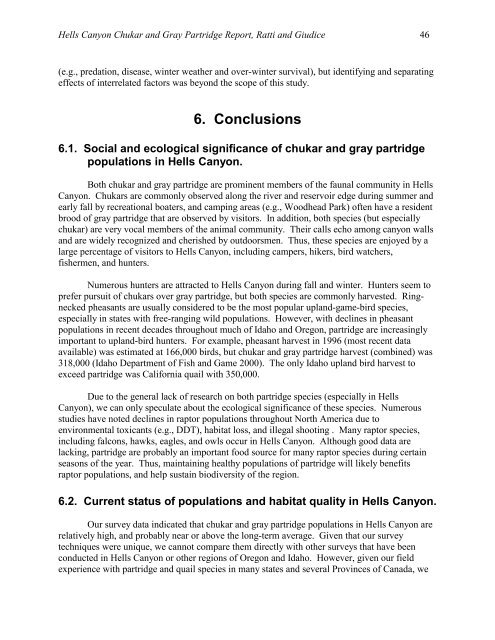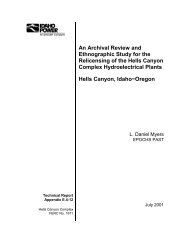Assessment of Chukar and Gray Partridge Populations - Idaho Power
Assessment of Chukar and Gray Partridge Populations - Idaho Power
Assessment of Chukar and Gray Partridge Populations - Idaho Power
- No tags were found...
You also want an ePaper? Increase the reach of your titles
YUMPU automatically turns print PDFs into web optimized ePapers that Google loves.
Hells Canyon <strong>Chukar</strong> <strong>and</strong> <strong>Gray</strong> <strong>Partridge</strong> Report, Ratti <strong>and</strong> Giudice 46(e.g., predation, disease, winter weather <strong>and</strong> over-winter survival), but identifying <strong>and</strong> separatingeffects <strong>of</strong> interrelated factors was beyond the scope <strong>of</strong> this study.6. Conclusions6.1. Social <strong>and</strong> ecological significance <strong>of</strong> chukar <strong>and</strong> gray partridgepopulations in Hells Canyon.Both chukar <strong>and</strong> gray partridge are prominent members <strong>of</strong> the faunal community in HellsCanyon. <strong>Chukar</strong>s are commonly observed along the river <strong>and</strong> reservoir edge during summer <strong>and</strong>early fall by recreational boaters, <strong>and</strong> camping areas (e.g., Woodhead Park) <strong>of</strong>ten have a residentbrood <strong>of</strong> gray partridge that are observed by visitors. In addition, both species (but especiallychukar) are very vocal members <strong>of</strong> the animal community. Their calls echo among canyon walls<strong>and</strong> are widely recognized <strong>and</strong> cherished by outdoorsmen. Thus, these species are enjoyed by alarge percentage <strong>of</strong> visitors to Hells Canyon, including campers, hikers, bird watchers,fishermen, <strong>and</strong> hunters.Numerous hunters are attracted to Hells Canyon during fall <strong>and</strong> winter. Hunters seem toprefer pursuit <strong>of</strong> chukars over gray partridge, but both species are commonly harvested. Ringneckedpheasants are usually considered to be the most popular upl<strong>and</strong>-game-bird species,especially in states with free-ranging wild populations. However, with declines in pheasantpopulations in recent decades throughout much <strong>of</strong> <strong>Idaho</strong> <strong>and</strong> Oregon, partridge are increasinglyimportant to upl<strong>and</strong>-bird hunters. For example, pheasant harvest in 1996 (most recent dataavailable) was estimated at 166,000 birds, but chukar <strong>and</strong> gray partridge harvest (combined) was318,000 (<strong>Idaho</strong> Department <strong>of</strong> Fish <strong>and</strong> Game 2000). The only <strong>Idaho</strong> upl<strong>and</strong> bird harvest toexceed partridge was California quail with 350,000.Due to the general lack <strong>of</strong> research on both partridge species (especially in HellsCanyon), we can only speculate about the ecological significance <strong>of</strong> these species. Numerousstudies have noted declines in raptor populations throughout North America due toenvironmental toxicants (e.g., DDT), habitat loss, <strong>and</strong> illegal shooting . Many raptor species,including falcons, hawks, eagles, <strong>and</strong> owls occur in Hells Canyon. Although good data arelacking, partridge are probably an important food source for many raptor species during certainseasons <strong>of</strong> the year. Thus, maintaining healthy populations <strong>of</strong> partridge will likely benefitsraptor populations, <strong>and</strong> help sustain biodiversity <strong>of</strong> the region.6.2. Current status <strong>of</strong> populations <strong>and</strong> habitat quality in Hells Canyon.Our survey data indicated that chukar <strong>and</strong> gray partridge populations in Hells Canyon arerelatively high, <strong>and</strong> probably near or above the long-term average. Given that our surveytechniques were unique, we cannot compare them directly with other surveys that have beenconducted in Hells Canyon or other regions <strong>of</strong> Oregon <strong>and</strong> <strong>Idaho</strong>. However, given our fieldexperience with partridge <strong>and</strong> quail species in many states <strong>and</strong> several Provinces <strong>of</strong> Canada, we
















